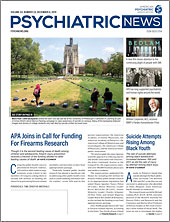The link between mental illness and violence has been much discussed in recent years, with media coverage inaccurately connecting mass shootings with mental illness while ideological and political divisions often obstruct efforts to address firearm suicides and homicides.
The October issue of Health Affairs was devoted to violence and health. During an event related to the issue, three researchers on the panel “Violence, Mental Health, and Suicide” presented their papers. They delved into policy options to prevent firearm suicides and overlapping factors in homicide and suicide.
One study examined the claim often made after mass shootings that greater access to mental health services would prevent firearm deaths. Evan Goldstein, M.P.P., a doctoral candidate at Ohio State University, and colleagues wanted to see whether this theory proved true regarding firearm suicides.
In their paper “Behavioral Health Care and Firearm Suicide: Do States With Greater Treatment Capacity Have Lower Suicide Rates?,” he and his colleagues compiled data from 2005, 2010, and 2015 from the Bureau of Labor Statistics Occupational Employment Statistics program and the National Survey of Substance Abuse Treatment Services to determine the behavioral health workforce size. They also pulled data on annual firearm suicide rates from the Centers for Disease Control and Prevention’s web-based Injury Statistics Query and Supporting System.
They found that across all states on average, a 10% increase in behavioral health workers was associated with a 1.2% relevant reduction in the firearm suicide rate. Goldstein called the association “a modest protective effect against firearm suicide.” But the findings may suggest that other interventions like improving firearm safety initiatives or limiting access to firearms may also have a protective effect “and may offer a larger return on public health investment,” the study stated. Another panelist, Catherine Barber, M.P.A., senior researcher at the Harvard T.H. Chan School of Public Health, spoke about a report she cowrote, “Linking Public Safety and Public Health Data for Firearm Suicide Prevention in Utah.” The study detailed how groups in Utah from across the ideological spectrum, including gun owners, worked together to address firearm suicide. A state-funded study to track firearm suicide patterns gained bipartisan support, allowing researchers to link public health and public safety data.
“Instead of vilifying gun owners as part of the problem, we’re seeing them as central to the solution,” Barber said.
Because the event included discussions of all forms of violence, not just suicide, this was a persistent question: In terms of prevention and policy solutions, does suicide need to be thought of as different from violence directed at another person?
There are numerous areas, both in terms of policy solutions and contributing societal factors, where homicide and suicide overlap. Violence is a “very gendered” issue, Barber said. Most perpetrators of both suicide and homicide are male. It has to do with “having brittle ego boundaries that say, ‘Only this far and no further. Once this line is crossed, I have an apocalyptic view of what needs to happen, whether it’s my obliteration or yours.’”
Often, violence comes down to individuals’ feeling whether they matter, said Bernice Pescosolido, Ph.D., a distinguished professor of sociology at Indiana University (
Psychiatric News). In terms of mass shootings, the goal of many shooters is often not only to create as many anonymous deaths as possible, but also to die by suicide. The feeling that they do not matter, she said, motivates a lot of violence.
Gender, Pescosolido added, is “absolutely critical” in understanding both suicide and homicide. Gender is associated with very different ways of thinking about how to deal with hurt, she said. The masculine cultural script often focuses on the idea that “it is better to burn out than fade away,” she said. ■
The “Violence and Health” edition of
Health Affairs is posted
here.

